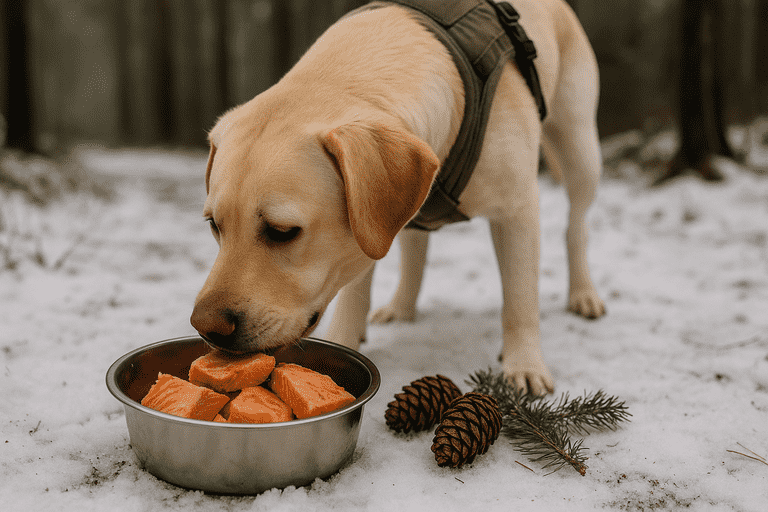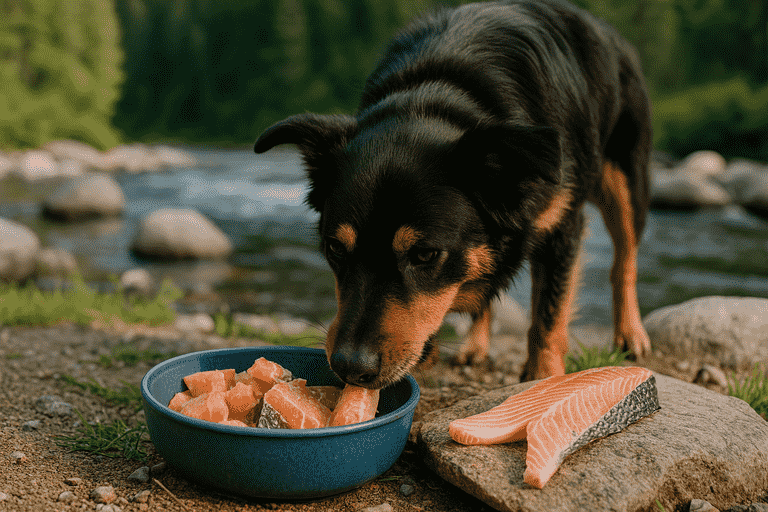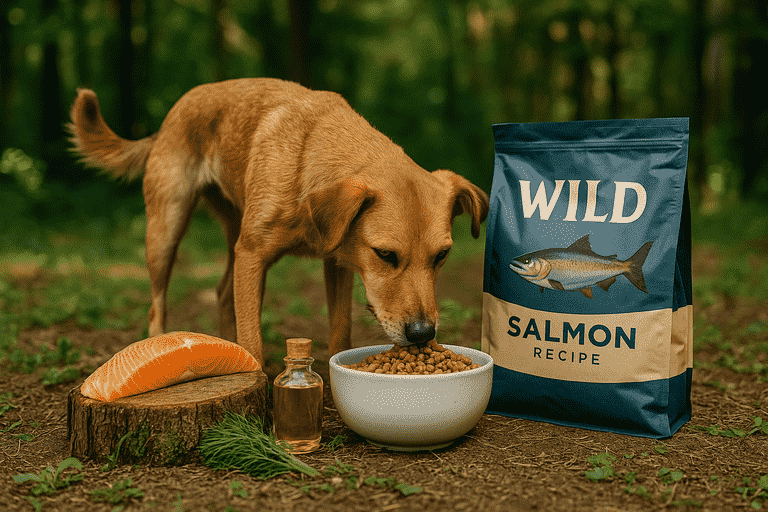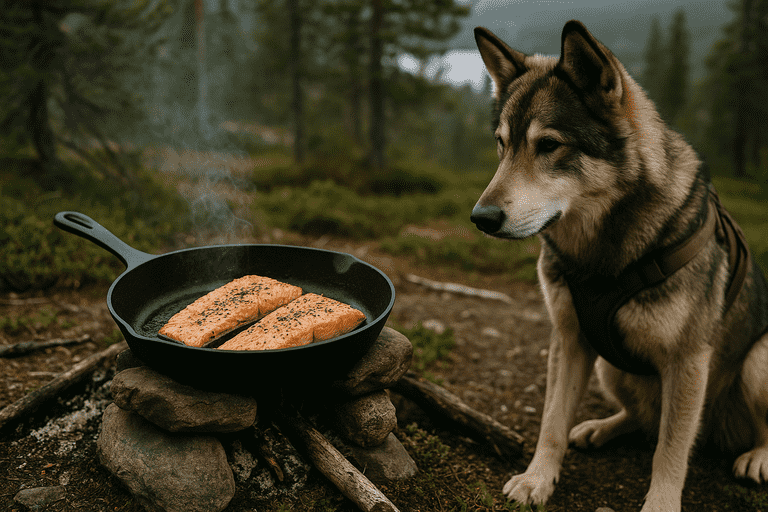Pet owners increasingly look for high-quality meals that align with their dog’s natural dietary instincts. Choosing wild dog food salmon ensures your pet receives protein-rich nutrition that supports energy and overall well-being. For instance, salmon offers essential fatty acids that promote healthy skin and a shiny coat.
In addition, dogs enjoy the flavor, making it easier to transition picky eaters. Therefore, this protein-packed option often satisfies both the pet and the owner seeking premium value.
Key Health Benefits
Dogs, like humans, benefit greatly from omega-3 and omega-6 fatty acids. These nutrients help reduce inflammation, support heart health, and boost the immune system. Products labeled as wild dog food salmon typically contain higher omega content than those using grain fillers or lower-grade meats.
Moreover, salmon-based food often assists dogs with sensitivities. It avoids common allergens like chicken or beef while still delivering a complete, balanced diet. Consequently, it becomes an excellent choice for dogs with food intolerances.

What Makes Wild Dog Food Salmon Stand Out From Other Protein Sources
Not all proteins are created equal. While chicken or lamb may dominate standard kibble, salmon provides a lean, digestible alternative with added nutritional perks. Dogs that consume wild dog food salmon often show improvements in coat texture, energy levels, and even joint health.
In addition, salmon-based formulas usually include fewer artificial additives. That means cleaner ingredient lists and less gastrointestinal stress. Choosing a cleaner food formula leads to visible results in a relatively short time.
How to Transition Your Dog to Wild Dog Food Salmon
Changing your dog’s diet requires a gradual approach to prevent digestive upset. Start by mixing a small portion of wild dog food salmon with your dog’s current food. Over the next 7 to 10 days, increase the salmon portion while decreasing the old food ratio.
Furthermore, observe your dog’s behavior and digestion during this period. Positive signs include stable stools, increased enthusiasm during meals, and improved hydration. Therefore, a smooth transition leads to lasting dietary improvements.

Understanding Ingredient Labels
Reading pet food labels can feel overwhelming, but it’s crucial for making informed choices. Look for clear labels where wild dog food salmon is listed as the primary ingredient—not as a meal or by-product. For example, “wild salmon” or “salmon filet” indicates higher quality sourcing.
Wild Food as a Gateway to Self-Reliance and Natural Living
In addition, avoid products with too many artificial preservatives, colors, or flavor enhancers. Natural additives like sweet potato, flaxseed, and blueberries complement salmon’s benefits and enhance the food’s nutrient profile overall.
Wild Dog Food Salmon for Dogs With Allergies and Sensitive Stomachs
Dogs prone to allergies often respond well to limited-ingredient diets. Many such diets use wild dog food salmon as the main protein to reduce risk of triggering food sensitivities. This type of formula eliminates common culprits like corn, soy, or dairy.
Moreover, the anti-inflammatory properties of omega-3s soothe irritated skin and digestive systems. As a result, dogs who switch to salmon-based diets often show rapid improvement in both appearance and comfort.

Choosing Between Dry, Wet, and Raw Options
There’s no one-size-fits-all format for dog food, especially when it comes to specialized diets. While some pet parents prefer dry kibble for its convenience, others opt for wet or raw formulas. Fortunately, wild dog food salmon is available in all three formats.
Best Bug Out Bag: The Ultimate Guide for Emergency Preparedness
Each option has its pros and cons. For instance, raw food mimics ancestral diets but requires careful handling. Wet food supports hydration, while kibble aids in dental health. Therefore, selecting the right version depends on your dog’s specific needs and your lifestyle.
How Much Should You Feed?
Feeding guidelines vary based on your dog’s weight, activity level, and age. Generally, packaging provides useful serving size recommendations. When serving wild dog food salmon, always use a proper measuring cup and adjust according to your vet’s guidance.
In addition, monitor your dog’s weight and energy output after dietary changes. You may need to fine-tune portions to maintain an ideal body condition. Keeping a consistent feeding schedule also improves digestion and appetite control.
Trusted Brands That Offer Formulas
Several premium pet food brands specialize in clean, salmon-based formulas. Look for companies with transparent sourcing and rigorous testing standards. The best wild dog food salmon products use real, wild-caught fish and avoid meat by-products entirely.
Atlas Survival Shelter Prices: A Comprehensive Guide
Brands such as Wellness, Blue Buffalo, and Merrick often receive high marks from pet owners. In addition, reading reviews and third-party certifications helps you select trustworthy options. Investing in quality now supports your dog’s long-term health.

Final Thoughts on Feeding Your Pet Wild Dog Food Salmon
Making the right dietary choice impacts your dog’s health, behavior, and lifespan. Switching to wild dog food salmon offers a range of proven benefits—from allergy relief to improved energy. In addition, most dogs love the taste, which makes mealtime enjoyable.
Therefore, if you’re seeking a natural, nutrient-rich formula that supports total wellness, salmon-based dog food delivers on all fronts. As always, consult with your veterinarian before making dietary changes, especially for dogs with specific health concerns.

